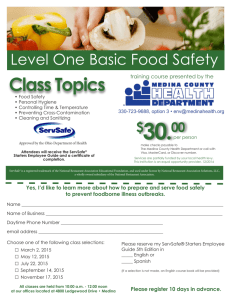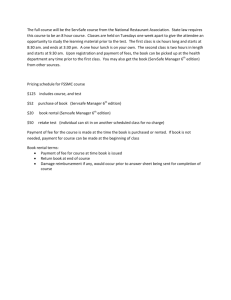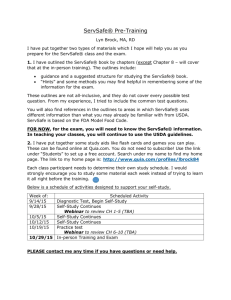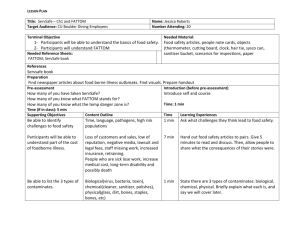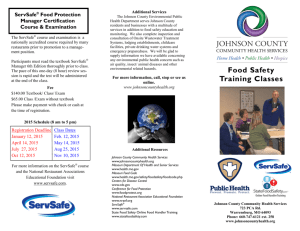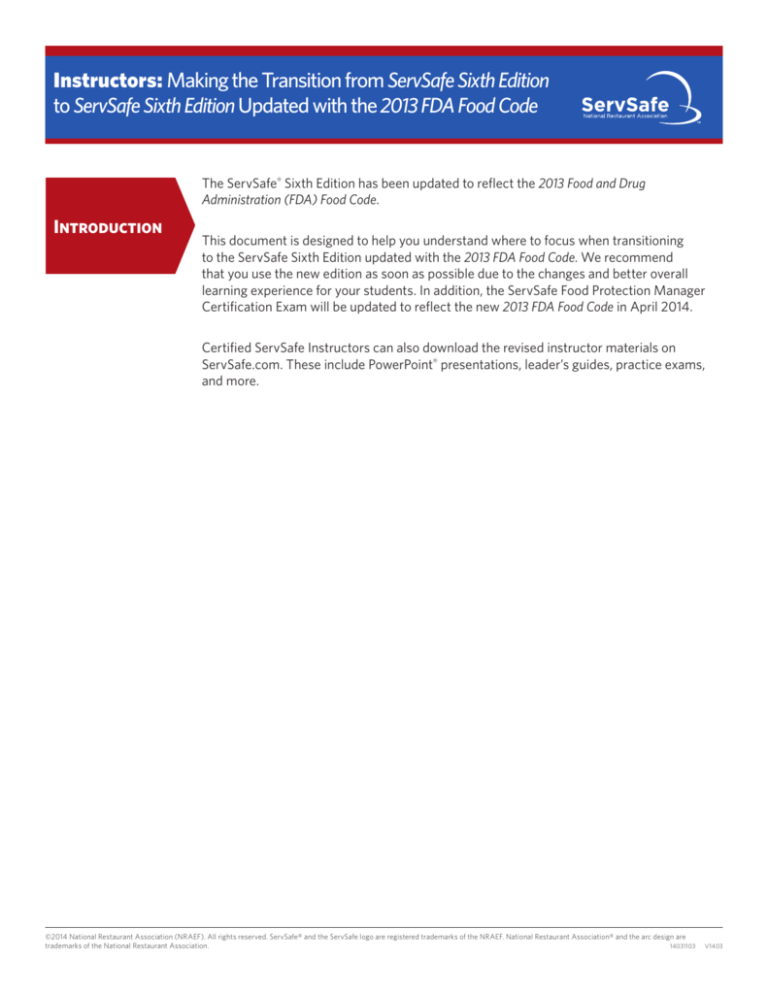
Instructors: Making the Transition from ServSafe Sixth Edition
to ServSafe Sixth Edition Updated with the 2013 FDA Food Code
The ServSafe® Sixth Edition has been updated to reflect the 2013 Food and Drug
Administration (FDA) Food Code.
Introduction
This document is designed to help you understand where to focus when transitioning
to the ServSafe Sixth Edition updated with the 2013 FDA Food Code. We recommend
that you use the new edition as soon as possible due to the changes and better overall
learning experience for your students. In addition, the ServSafe Food Protection Manager
Certification Exam will be updated to reflect the new 2013 FDA Food Code in April 2014.
Certified ServSafe Instructors can also download the revised instructor materials on
ServSafe.com. These include PowerPoint® presentations, leader’s guides, practice exams,
and more.
©2014 National Restaurant Association (NRAEF). All rights reserved. ServSafe® and the ServSafe logo are registered trademarks of the NRAEF. National Restaurant Association® and the arc design are
trademarks of the National Restaurant Association.
14031103
V1403
2
Instructors: Making the Transition from ServSafe Sixth Edition to ServSafe Sixth Edition Updated with the 2013 FDA Food Code
Topic/ Issue/Change
Chapter Reference
ServSafe Manager Book Chapter—Forms of Contamination
ServSafe Coursebook Chapter—Understanding the Microworld
1Nontyphoidal Salmonella was added to the “Big Five” list of pathogens that cause
foodborne illness. The list is now referred to as the “Big Six.”
ServSafe Manager Book:
Biological Contamination 2.3
ServSafe Coursebook:
The Big Six 2-3
2Nontyphoidal Salmonella was added as a fourth type of major bacteria that causes
foodborne illness.
ServSafe Manager Book:
Major Bacteria that Cause
Foodborne Illness 2.5
ServSafe Coursebook:
Major Foodborne Bacteria 2-13
3The reference to E. coli has changed from Enterohemorrhagic and shiga toxin-producing
E. coli to simply shiga toxin-producing E. coli.
ServSafe Manager Book:
Major Bacteria that Cause
Foodborne Illness 2.5, 2.6
ServSafe Coursebook: Major
Foodborne Bacteria 2-11
4The prevention measures have changed for shiga toxin-producing E. coli, Shigella spp.,
Hepatitis A, and Norovirus to align with the revised exclusion/restriction chart for
handling staff illnesses.
ServSafe Manager Book:
Major Bacteria that Cause Foodborne
Illness 2.5, 2.6; Major Viruses that
Cause Foodborne Illness 2.7
ServSafe Coursebook:
Major Foodborne Bacteria 2-11,
2-14; Major Foodborne Viruses 2-19
Chapter—The Safe Food Handler
1The requirement that hands be washed before putting on gloves has been changed to
reflect the need to do so only at the start of a new task under certain conditions.
ServSafe Manager Book:
How to Use Gloves 3.9
ServSafe Coursebook:
How to Use Gloves 4-8
2New exceptions have been added to the requirement that no bare-hand contact occur
with ready-to-eat food.
ServSafe Manager Book:
Bare-Hand Contact with
Ready-To-Eat Food 3.10
ServSafe Coursebook:
Bare-Hand Contact with
Ready-To-Eat Food 4-7
3The exclusion/restriction chart for handling illnesses has been updated to reflect the
exclusion of food handlers with vomiting or diarrhea and illnesses from specific pathogens.
ServSafe Manager Book:
Handling Staff Illnesses 3.13
ServSafe Coursebook:
Handling Staff Illnesses 4-11
©2014 National Restaurant Association (NRAEF). All rights reserved. ServSafe® and the ServSafe logo are registered trademarks of the NRAEF. National Restaurant Association® and the arc design are
trademarks of the National Restaurant Association.
14031103
V1403
Instructors: Making the Transition from ServSafe Sixth Edition to ServSafe Sixth Edition Updated with the 2013 FDA Food Code
Topic/ Issue/Change
3
Chapter Reference
ServSafe Manager Book Chapter—The Flow of Food: Purchasing,
Receiving, and Storage
ServSafe Coursebook Chapter—The Flow of Food: Storage
1The labeling requirements for food packaged on-site for retail sale have changed
to recognize the requirement to identify sub-ingredients on the label.
ServSafe Manager Book:
Labeling Food That is Packaged
On-site for Retail Sale 5.8
ServSafe Coursebook:
Labeling Food That is Packaged
On-site for Retail Sale 7-2
Chapter—The Flow of Food: Preparation
1There is a new requirement to remove reduced-oxygen packaged (ROP) fish from the
package when thawing it.
ServSafe Manager Book:
Thawing 6.3
ServSafe Coursebook:
Thawing 8-3
2There is a change in the requirement for partial cooking that identifies the need to
heat the food to its required minimum internal temperature before service.
ServSafe Manager:
Partial Cooking During Preparation 6.11
ServSafe Coursebook:
Partial Cooking During Prepping 8-11
Chapter—The Flow of Food: Service
1There are new requirements for refilling returnable food and beverage containers
brought back by guests.
ServSafe Manager Book:
Kitchen Staff Guidelines 7.5
ServSafe Coursebook:
Kitchen Staff Guidelines 9-5
Chapter—Cleaning and Sanitizing
1There is a new requirement that operations using high-temperature dishwashers provide
staff with an irreversible method for measuring the surface temperature of sanitized
items.
ServSafe Manager Book:
Dishwasher Operation 10.8
ServSafe Coursebook:
Dishwashing Machine Operation 12-9
2There is a new requirement that operations check with the local regulatory authority to
determine if a written cleanup plan is required for cleaning up after people who get sick
in the operation.
ServSafe Manager Book:
Cleaning Up After People Who
Get Sick 10.12
ServSafe Coursebook:
Cleaning Up After People Who
Get Sick 12-12
©2014 National Restaurant Association (NRAEF). All rights reserved. ServSafe® and the ServSafe logo are registered trademarks of the NRAEF. National Restaurant Association® and the arc design are
trademarks of the National Restaurant Association.
14031103
V1403

